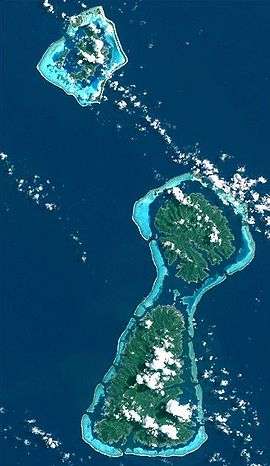Taha'a
| Taha’a | |
|---|---|
| Commune | |
 Location of the commune (in red) within the Leeward Islands | |
| Coordinates: 16°37′00″S 151°30′00″W / 16.6167°S 151.5°WCoordinates: 16°37′00″S 151°30′00″W / 16.6167°S 151.5°W | |
| Country | France |
| Overseas collectivity | French Polynesia |
| Government | |
| • Mayor | Ismaël Tuahu |
| Area | 90.2 km2 (34.8 sq mi) |
| Population (August 2007 census)1 | 5,003 |
| • Density | 55/km2 (140/sq mi) |
| INSEE/Postal code | 98745 /98733 |
| Elevation | 0–590 m (0–1,936 ft) |
| 1 Population without double counting: residents of multiple communes (e.g., students and military personnel) only counted once. | |
Taha’a (sometimes spelled as "Tahaa") is an island located among the western group, the Leeward Islands, of the Society Islands in French Polynesia, an overseas territory of France in the Pacific Ocean. The islands of Taha’a and neighboring Raiatea to the immediate south are enclosed by the same coral reef, and they may once have been a single island. Tahaa has 5,000 people living on 90 square kilometres (35 square miles), and reaches a maximum height of 590 metres (1,940 ft). It is also known as the "Vanilla Island" and produces pearls of exceptional quality.
Administration
Administratively, Taha’a and the surrounding islets emerging from the coral reef form a commune (municipality) part of the administrative subdivision of the Leeward Islands. Tahaa consists of the following associated communes:
- Faaaha
- Haamene
- Hipu
- Iripau
- Niua
- Ruutia
- Tapuamu
- Vaitoare
The administrative centre of the commune of Tahaa is the settlement of Patio.
Vanilla production
Taha’a produces 70-80% of all French Polynesia's vanilla. Because of the pervasive aroma of vanilla, Taha’a is known as the "Vanilla Island". Taha’a's pearls are of exceptional quality.
Accessibility
Taha’a and its small islets can be reached by boat and outrigger from Raiatea. The short sail drops visitors on an islet beach with a small lagoon, and in the near distance, a view of Bora Bora. These parts of the Society Islands are less modernized.
Tahitian Spelling
Taha’a is spelled in Tahitian using the apostrophe (in fact a variant of it, the okina, hard to differentiate from the regular apostrophe when using small fonts) to represent the glottal stop, as promoted by the Académie Tahitienne and accepted by the territorial government.[1] This apostrophe, however, is often omitted. In old travelogues, the transcription Oataha is sometimes used.
References
| Wikimedia Commons has media related to Taha'a. |
